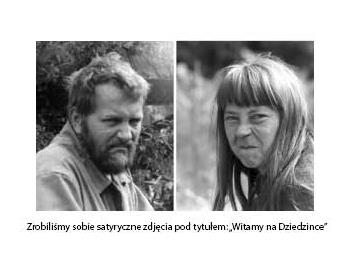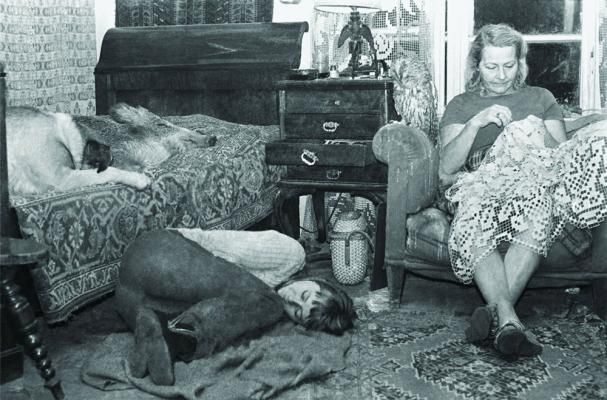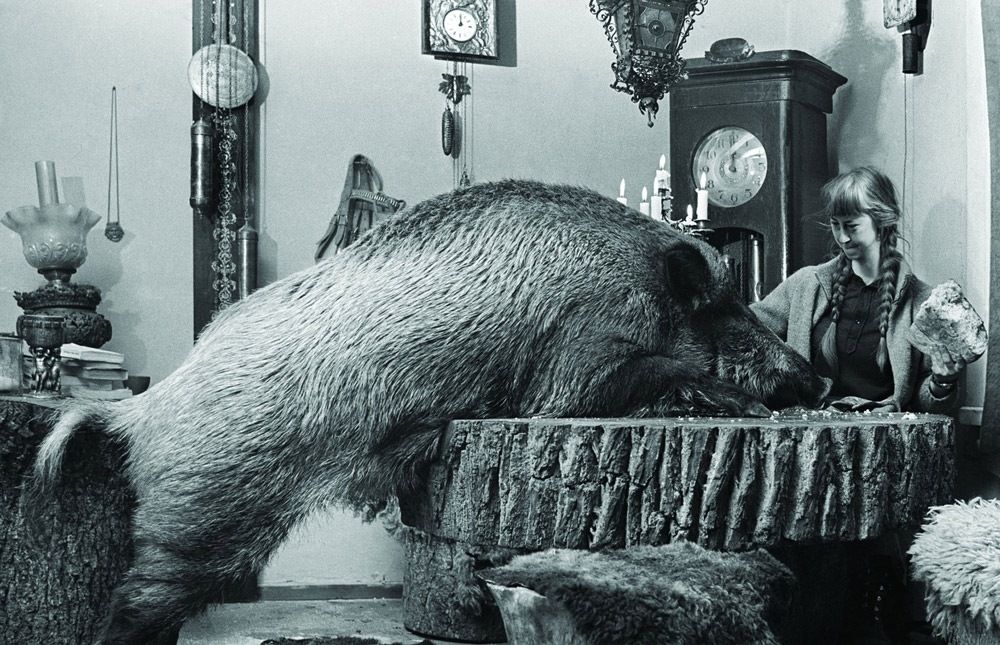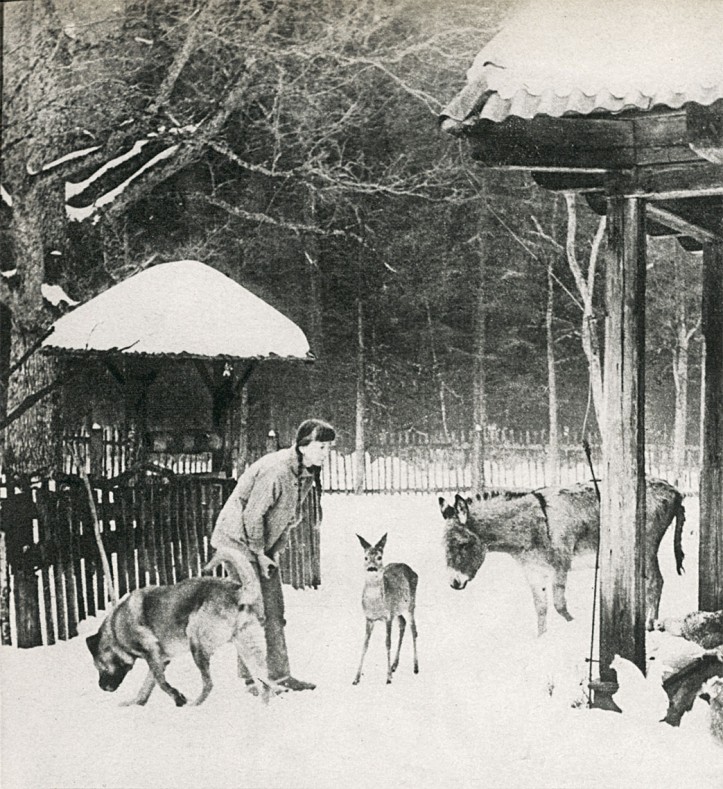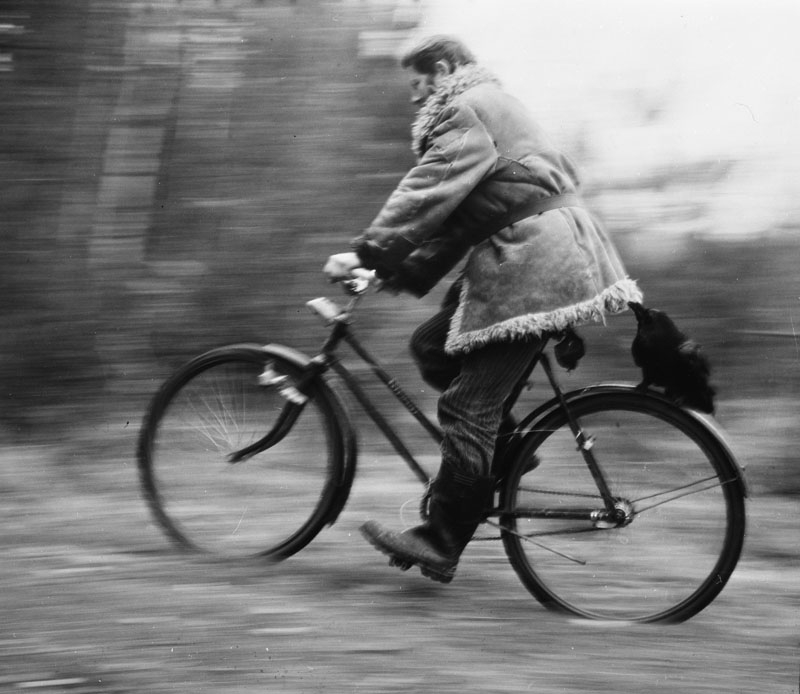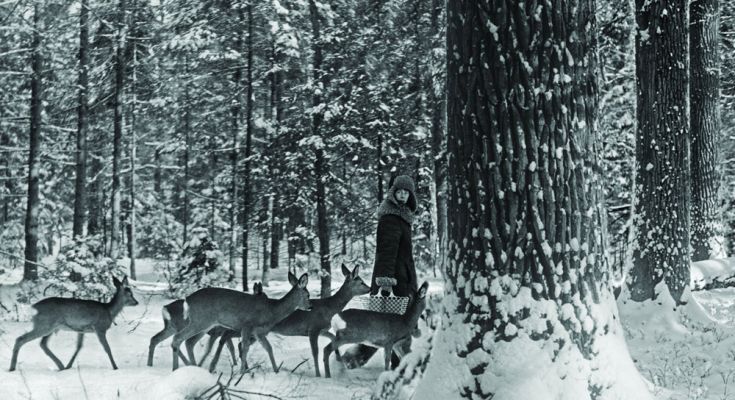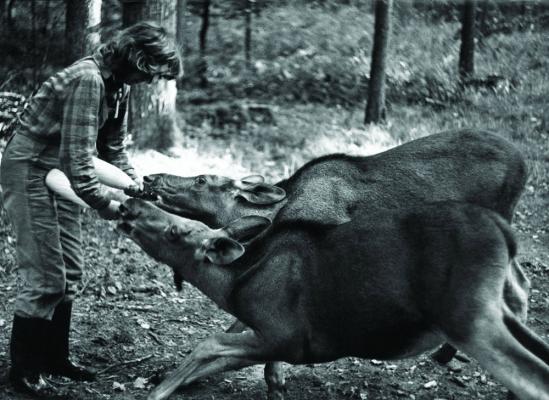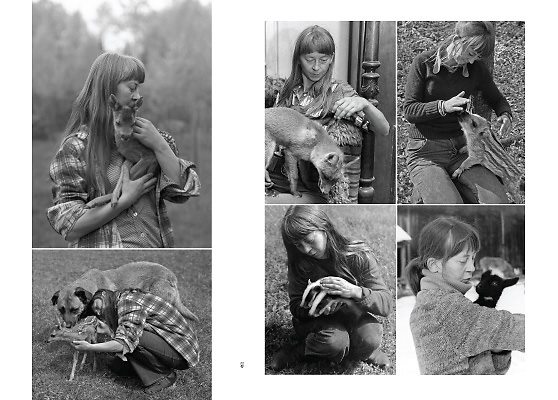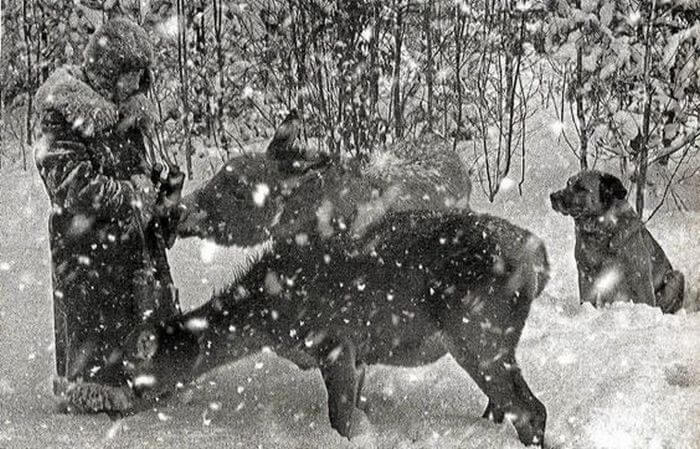Simona Kossak
They called her a witch, because she chatted with animals and owned a terrorist-crow, known for stealing gold and attacking bicyclists. A lynx slept in her bed, and she shared her roof with a tamed boar. Simona Kossak was a scientist, ecologist and the author of award-winning films - as well as an activist who fought to protect Europe's oldest forest.
Janusz R.
Kowalczyk, Jul 2015
Simona Kossak
She was the great-granddaughter of Juliusz Kossak, the granddaughter of Wojciech Kossak, and the daughter of Jerzy Kossak - three painters who loved both Polish landscapes and history. She was also a niece of Maria Pawlikowska-Jasnorzewska the poet and Magdalena Samozwaniec, the writer. Simona was meant to be a son and the fourth Kossak - carrying easels and carrying on her famous surname.
Instead, she spent more than 30 years in a wooden hut in the Białowieża Forest - without electricity or access to running water. Simona believed that life ought to be simple and close to nature. Living amongst animals, she found something that she never could with her fellow humans.
>> Janusz R. Kowalczyk, Jul 2015 [Culture]
Episode: File 0066: Crime & Biology: Special Task Force Pt. 2
Release Date: April 8 2022
Researched and presented by Cayla
Simona Kossak completed her degree in Zoology at the Jagiellonian University in Kraków in 1970, with a specialization in psychology and animal ethology (i.e. animal behaviour). Her dream was to settle down in the Bieszczady mountains, in the Hulski Valley, which was still wild at the time. She was promised the position of curator at a yet non-existent museum in a yet non-existent national park. As the matter was being constantly delayed, Simona, an admirer of the Bieszczady mountains (she had been spending her holidays there for the past 10 years) abruptly changed direction, packed her suitcase, and after several hours of train travel, got off in...
Białowieża. It was the middle of winter, 1st February
1971, when she started a job at the Mammal Research Institute of the
Polish Academy of Sciences there. She moved into a guest room, yet
quietly still had dreams of Bieszczady. But one day, an
acquaintance and later good friend, Barbara Ewa Wysmułek, who was a Polish
language scholar and wife of a National Park and Palace
Park forest ranger, said: "Simona dear, Dziedzinka would appeal to you. Perhaps the place is a bit haunted, but you are quite
brave. You must go see this wonderful spot."
'Simona first saw Dziedzinka in moonlight', Ewa Wysmułek remembers:
We decided we would go there at night time. The four of us went down the road with torches: my husband, a hired carter, myself and Simona. >> Janusz R. Kowalczyk, Jul 2015 [Culture]
As they approached the location of the hut, a large creature cross their path
Simona: It was the first aurochs that I ever saw in my life - I am not counting the ones in the zoo. Well, and this greeting right at the entry into the forest - this monumental aurochs, the whiteness, the snow, the full moon, whitest white everywhere, pretty [...] and the little hut hidden in the little clearing all covered with snow, an abandoned house that no one had lived in for two years. In the middle room, there were no floors; it was generally in ruins. And I looked at this house, all silvered by the moon as it was, romantic, and I said, 'it's finished, it's here or nowhere else!' >> Janusz R. Kowalczyk, Jul 2015 [Culture]
The next day she showed up at the office of the director of Białowieża National Park, as the forest lodge was located within its boundaries, and proceeded to request that it be assigned to her as staff housing. The director at the time, engineer Józef Budzyń, interrogatively eyed the slender girl, who had this whim to commute six kilometres to work winter or summer, of her own free will; he agreed, yet noted that a prominent photographer from Warsaw, Lech Wilczek, was also making efforts to occupy Dziedzinka. On 24th March 1971, on her own name day, Simona moved in. About a fortnight later, her neighbour moved into the second part of the house.

The next day she showed up at the office of the director of Białowieża National Park, as the forest lodge was located within its boundaries, and proceeded to request that it be assigned to her as staff housing. The director at the time, engineer Józef Budzyń, interrogatively eyed the slender girl, who had this whim to commute six kilometres to work winter or summer, of her own free will; he agreed, yet noted that a prominent photographer from Warsaw, Lech Wilczek, was also making efforts to occupy Dziedzinka [Je-jean-yetz]. On 24th March 1971, on her own name day, Simona moved in. About a fortnight later, her neighbour moved into the second part of the house.
Before Simona went to live in Dziedzinka, the house had to
be renovated. The employees of the Białowieża National Park
repaired the roof, changed the joists, got rid of the fungus, and said that
ought to suffice for five years (and indeed it did). After the
renovations, Simona started to arrange her part of Dziedzinka. She plastered the walls with wallpaper, washed the windows,
placed the sofa and bench, and upholstered the armchairs
that were brought over from Kraków.
She brought clocks, decorations, oil lamps and furniture from Kossakówka. And she didn't care when Jacek Wysmułek said to her: 'You won't make a Kossakówka out of Dziedzinka'.
A large tile stove in the old style stood in the corner of Simona's room, and a large table was placed in its middle - it was her workshop study, where she worked by an oil lamp. Her mother, Elżbieta Kossak, would bring books and furniture from Kossakówka when she came to visit.
The road to the cabin wasn't in the greatest shape. For a long time horse and/or horse and carriage was the most common access, but eventually automobiles could make the trek. But for Simona? Well she was known to use Fiat Maluch a little all-terrain car and cross-country skies to move about the forest, but most famously was her 'komar' motorbike.
The roads of the forest were filled with mud and were regularly destroyed by vehicles carrying wood out of the forest, her little 'komar' was the most reliable form of transportation
Simona's
neighbor was Lech Wilczek, an author
and photographer whose primary passion was nature and its preservation.
With similar interests and goals you would think they would've immediately got
on. But that was not the case, both thinking the other was full of themselves,
but living the same building, they had to tolerate each other's presence
The Witch of the Wilds
Tomasz Werkowski, a hunter from Białowieża, recalls:
'Once I saw this phenomenon advancing on a komar - wind in the hair, a pilot-cap, rabbit pants, and eye goggles. It passed me by and I had to turn around, because I didn't know what it was. This was in 1974, the very first time that I saw Simona'.
No
matter what the season, the komar was her ride. In the winter, she rode her komar
to work, with her hands freezing to the handles. Professor
Kajetan Perzowski, a colleague of Simona from her university years
in Kraków, says
Once, with a friend, I was going across the Białowieża Forest in a small truck. Suddenly, we see someone pushing through the snowdrifts carrying a motorbike on their back. It was Simona. We packed her together with this motorbike onto our truck. She thanked us later, heating up a big pot of bigos at Dziedzinka.
Simona's mother, Elżbieta, would come and spend the summers with her daughter. For the winter, she would return to the hut in Kossakówka. She had problems with her hip and often required crutches to walk, getting about Dziedzinka was tricky, especially with the outdoor privy. But for this woman, who grew up homesteading, this was true paradise, this was home.
Life on Dziedzinka did resemble an atmosphere of a manor in the summer. There was reading by the light of oil lamps, keeping hens, and with time, also spinning wool. On top of that, the chime clocks from Lech Wilczek's collection resounded every hour.
Simona's love of animals of all kind, naturally led to the property quickly becoming a zoo between animals she rescued, domestic animals she had acquired and the wild critters she had befriended. Early on she had an owl and three buzzards, so when Lech came across four abandoned owl chicks, he brought them over in a basket. This would begin their joint animal menagerie
It only made sense. They both loved the isolation of the ancient forest and the connection it gave them with nature. With Simona's work for the Mammal Research Institute and Lech's wildlife photography and writing it was the perfect place. And both adored their animal companions.
The animals they rescued, weren't captive. The owls would eventually go their own way. The buzzards? When she released them, they came back and would escort Simona to and from the little hut for sometime before finally going their own way.
Zabka, The Boar
It was a baby boar that would be named Zabka [Froggy] that would bring them together.
Zabka had been found, one-day old and was brought to Lech to care for, he brought the piglet home to Simona's delight and together they would raise the boar. They'd alternate nights, as due to the cold, the piglet had to sleep in their beds and even if one of them had to go away for a reason, someone was always there for the little boar.
Zabka hated being alone, and behaved more like a dog than a boar, following her owners around and she would often steal things from her parents just to make them chase after her. She was also very affectionate and frequently demanded cuddles and chin scratches.
Through this co-parenting, Lech and Simona got to know each other, and eventually to liking each other. They would be together for the rest of their lives.
At dinner, Simona says jokingly: "Lech loves our animals, but I think he likes me a bit too, because I'm the only woman within a range of five kilometres."
"But I have a motorcycle, love, and besides, I have plenty of other women only four kilometres away," retorts Lech.
Written by Zbigniew Święch [przekroi]

And
their hairy love-child? Zabka grew into a massive boar, while I
don't have the exact dimensions of Zabka, it's common for adult boars of her
species to weigh between 130-220 lbs, with reports of boars that have reached
over 400 lbs. Zabka would be with them for 17 years. Despite her
size, she's as gentle as can be with her parents, though she can be shy around
guests, and will aggressively defend the property from strangers.
Hepunia, The Donkey
On April 1973, Janusz Kocięcki, head of breeding at the Poznań Zoo, came to Dziedzinka and declared: "I'm sure you need a donkey."
And thus they acquired Hepunia. Hepunia
was mischievous and loved to travel. She was known for wandering off to the
woods sometimes on grand adventures, even attempting to cross into the Soviet
Union twice, but the border guards turned her away and called her parents.
Korasek, The Crow
But Zabka was far from the only wild animal Simona befriended. Terror flew on black wings, and his name was Korasek. The corvid was known to terrorize half of the Białowieża area. He stole cigarette cases, hair brushes, scissors, cutters, mouse traps and notepads. He attacked people. He tore up bicycle seats. He stole documents, he stole lumberjacks' sausages in the woods, and made holes in grocery bags. He clung at men's pant legs, pulled at women's skirts, and pricked their legs. People thought that he was some kind of a punishment for their sins. And he was Lech's favorite companion
Stanisław Myśliński, who has scars from the bird to this day, recalls:
He would even steal workers' pay in the woods. He once stole my permit for entering the woods. He pulled it out of my pocket and notoriously tore it apart. He loved to attack people who rode bicycles, especially girls. It was very impressive - he would attack the rider's head with his beak, the person would fall off, and he then would sit on the seat triumphantly, looking the at the spinning wheel. >> Janusz R. Kowalczyk, Jul 2015
Simona's friend says:
Once he stole my car keys. And Lech [Wilczek] said: 'Don't worry, he'll bring them back'. He took a metal rod and scared the crow: 'You sonofabitch, you took keys from a friend?!' He and I said to Korasek that if he brings them back, he'll get an egg, and if he doesn't, he'll get a blow with the rod. And the crow perhaps understood this, because after a moment, he flew up to me, furious, with the keys in his beak and threw them onto a table! >> Janusz R. Kowalczyk, Jul 2015

Bożena Wajda recalls:
Once, I was walking around the reserve without a permit, and the guard saw me, he followed me to Dziedzinka and started to fill in a fine penalty. When he was handing the print to me, the crow appeared. He took the paper in his beak, flew onto the roof of Dziedzinka with it, and tore it up with his leg, on top of that roof. I had such a laughing attack that I couldn't control myself, the guard didn't know what to do, and finally, he just shrugged his shoulders at the whole thing. >> Janusz R. Kowalczyk, Jul 2015
Before I even make it to the porch, Korasek the crow first pecks at my leg around my ankle and then proceeds to steal a pen from my pocket; fortunately, he is open to bribes and returns it in exchange for an egg
All the lumberjacks and sawmen in the area need to constantly keep an eye on their power saws; otherwise Korasek nicks the screws and spark plug boots and steals their lunches. In spite of it all, people like him
Written by Zbigniew Święch [przekroi]
And it wasn't just people that had to worry about Korasek's mischief, he also liked to harass the animals, with the exception of Zabka, whom he was afraid of. He'd often ride on Hepunia's back and heckle the chickens. But while devious and almost malicious with outsiders, Korasek loved his parents.
When Simona would ride her motorcycle, he would sit on her head or the back seat, making sure she got to her destination safe
For the locals of Białowieża it was a common sight to see Lech walking down main street and Korasek flying overhead, frequently flying down low, landing on Lech's shoulder and cuddling up against his face.
In the forest though, Korasek isn't the only one to follow Lech, with Zabka and Hepunia regularly at his side.

The Deer
Simona had hand-raised a pack of deer that would go on to live in the woods
Simona recalled:
One day, the pack of my deer [...] manifested signs of fright, and did not want to go out onto the forest field to graze. And I started to approach the young forest, because this was the direction in which the deer started, their ears raised, and the hair standing up on their buttocks, apparently something very threatening had to be there in the young forest. I crossed about half of this open space, and I stopped, because I heard a choir of terrified barking behind me, so I turned around, and what did I see? [...] Five of my deer stood up on their stiffly straightened legs, looking at me, and calling with this bark: don't go there, don't go there, there's death over there!
I must admit, I was dumbstruck, and then finally I did go. And what did I find? It turned out that there were fresh traces of a lynx that had crossed the young forest. I went in deeper, and I found lynx faeces; it was indeed warm, because I touched it. What did that mean? It meant that a carnivore had entered the farm, the deer noticed him, then ran and they were scared, and what did they see? They saw their mother going unto death, completely unaware, she had to be warned, and for me, I will honestly admit, this day was a breakthrough. I crossed the border that divides the human world from that of the animals. If there was a glass that divided us from humans, a wall impossible to knock down, then the animals would not care about me. We are deer, she is human, what do we care for her? If they did warn me [...], it meant one thing and one thing only: you are a member of our pack, we don't want you to get hurt. I honestly admit, I relived this event for many days, and in fact today, when I think about it, there is sense of warmth around my heart. It proves how one can befriend the world of wild animals.
>> Janusz R. Kowalczyk, Jul 2015 [Culture]
Other Animals
With time, more animals appeared in Simona's den by the house: a doe who approached the window and ate sugar, a black stork for whom Simona created a nest in a chest in her room, a dachshund and a female lynx that slept in the same bed with Simona, as well as peacocks. Dziedzinka quickly became an experimental laboratory which Simona consequently expanded as a zoo psychologist - with a hospital and a waiting room for sick animals.
Here, she healed, hugged, and observed the animal lot together with Wilczek, who photographed them. Here, as a mother she raised moose twins, Pepsi and Cola, washed the neck of the black stork, took the female rat Kanalia into her sleeve (as the animal panicked in open spaces). She let the befriended doe give birth on the patio, took in lambs with their mother, kept and observed the rats Alfa and Omega, and keep crickets in a glass container. It was here that she checked on the weather by observing bats in the basement. The menagerie grew with each year.
>> Janusz R. Kowalczyk, Jul 2015 [Culture]
Wolves and Linxes
In the winter of 1993, Simona commenced her battle for saving the lynxes and wolves of Białowieża from perdition. In an article for Twój Styl (Your Style) magazine, Alina Niedzielska wrote, for example, that:
A group of young workers from the Mammal Research Plant of the PAN Polish Academy of Sciences came up with the idea of telemetric studies. A wild animal is given a collar with a radio transmitter, so that it would pass out information as it walks about the woods. But the carnivore must first be caught. [...] it was revealed that the researchers set up traps for the wolves and lynxes, which are prohibited by Polish law.
Simona came across two metal jaw traps, so she took them with her and refused to give them back. She was accused by the scientist of stealing the research apparatus. The matter was investigated by the Regional Prosecution in Hojnówka and the 2nd Criminal Section of the Regional Court in Bielsko Podlaskie. During the hearing conducted by the Prosecution, in response to the question what kind of a threat such research apparatus in the Białowieża Forest presented to animals, Simona answered:
In my opinion, it was a lethal threat not only to the animals, but also the guards. [...] Each animal that falls into the trap is potentially condemned to die, if the wound to the paws is heavy. With a population that numbers 12 specimen, and including poaching and chance deaths of wild animals, it is a lethal threat to the continuity of the lowland lynx type, whose genetic scope is unique across all of Europe, because there are no more lowland lynxes in Europe. It is a disgrace to the world of science for us to have contributed to this.
Life on the Homestead
Every Christmas Eve, the two of them decorate the spruce tree
that grows in the clearing in front of the house. They adorn the branches with
everything that birds and wild animals are fond of: rowanberries, lard,
apples and dried fruit. They also set out a pile of hay for the deer
that pass through Dziedzinka [Je-jean-yetz]as they venture deep into the
primeval forest.
At the table, the now giant Żabka
receives (while standing on her hind paws like a dog) a loaf of bread
(see photo!), acorns, and apples in a basket decorated with pine
branches. Hepunia receives a couple pounds more of apples and
lots of carrots and oats, as much as she can eat. There are two
mice for the owl, and Korasek the crow receives eggs
with mayonnaise and a tap on the head so it doesn't get too big.
Conclusion
Simona would spend the rest of her life here and her commitments to conservation and the understanding of wildlife received numerous recognitions over the years
- 1980: the Scientific Council of the Forest Research Institute award Simona with a doctoral degree in Forest Sciences on the basis of her doctoral dissertation "Research on the trophic situation of roe deer in the habitat of fresh mixed coniferous forest in the Białowieża Primeval Forest"
- 1991, with a postdoctoral degree in Forest Sciences on the basis of her postdoctoral dissertation "Environmental and intraspecific determinants of the feeding behavior of roe deer (Capreolus capreolus L.) in the forest environment"
- 1997, she received the academic title of Professor of Forest Sciences
- In October 2000, Kossak was awarded the Golden Cross of Merit: Cross of Merit was the highest civilian award in Poland. It was awarded to citizens who went beyond the call of duty in their work for the country and society as a whole
- 2003: Kossak worked at the Mammal Research Institute of the Polish Academy of Sciences in Białowieża and at the Forest Research Institute at the Department of Natural Forests, where she was the director from January 2003 until her death in 2007.
- She was also one of the originators of the UOZ-1 repeller, a device that warns wild animals of passing trains
The creative output of prof. dr hab. Simona Kossak includes a total of over 140 original scientific studies, pop-science articles, unpublished scientific documentation and 4 books
Kossak passed on March 15 2007
Opening of Simony Kossak Street. Białowieża March 18,
2017
Dziedzinka was made into a monument
Lech continued his and Simona's work up until his death. He went on to write and publish and handful of books, but his last book was "Meeting with Simona Kojak" a biography about Simona full of never before seen pictures of their life together and dedicated to her work and passion. He died in Dec 2018
Today, Simona's niece, Joanna Kossak keeps her aunt's memory alive. Growing up, Joanna spent every vacation she could at her aunt's house and considered her liked a mother. Joanna performs talks educating people about Simona and her work. Joanna herself is a painter and said that one day she would like to write a book about Simona and Lech, but she needs more time to grieve
"Man is also a part of nature, and there are no more [or] less important parts in it. A flower, a star, a stone, a man is permeated with the same divine spark. Those who learn to sympathize with plants and animals can understand others and will be better for themselves, that is, they will do nothing against their nature. " Simona
2024 UPDATE
In November a film loosely based on Simona Kossak, the Polish ecologist, was released





